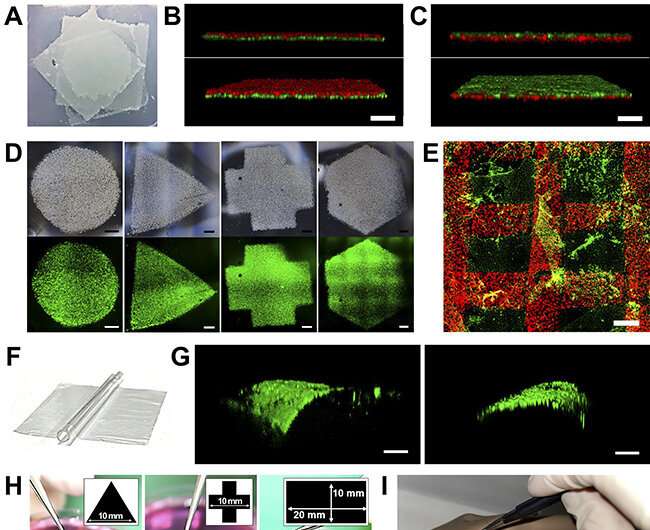
Recently, a team of Korean and international researchers reported the successful development of a transfer-tattoo-like cell sheet that can be directly applied to targeted surfaces. The cell sheet delivery system has shown promising potential for facilitating cutaneous wound healing and promoting skin tissue regeneration, particularly in complex and broad injuries such as burn wounds.
A research team at POSTECH led by Professor Sungjune Jung from the Department of Materials Science and Engineering, in collaboration with researchers headed by Roisin M. Owens at the University of Cambridge and a team led by Professor Jae Ho Kim at Pusan National University’s School of Medicine have developed a cell sheet delivery system that allows for the direct transfer of a cell sheet to targeted tissues. The findings were published in Advanced Materials.
Traditional approaches for damaged tissue regeneration involve the injection of cell suspensions. However, this method often fails to ensure optimal adhesion of injected cells to targeted tissues, leading to suboptimal regenerative effects. In response, a novel cell sheet delivery system was introduced to enhance cellular adhesiveness. Yet, conventional cell sheet systems require the detachment of cell sheets from a surface triggered by detrimental external stimuli in order to deliver the sheets to target tissues.
The joint team used a mechanism of natural cell migration between surfaces to develop the world’s first cell sheet delivery system. This system enables the transfer of cell sheets to a target surface with different adhesion preferences without the need for deleterious external stimuli.
To achieve this, the team utilized a flexible parylene membrane approved by the FDA for use as a cell culture surface. The team’s UV-treated parylene surface demonstrated both stable cell binding during culture and adequate levels of cell adhesiveness for efficient transfer to a target tissue.
The team’s cell sheet engineering leverages the inherent migratory properties of cells, thereby removing the need for external stimuli and detachment processes. Compared to traditional techniques, their approach boasts high levels of biocompatibility, process simplification, and workflow convenience.
Moreover, their research demonstrated for the first time that the vertical migration of cells between two distinct surfaces is feasible, beyond the well-known horizontal migration. The team has termed this vertical migration process “interfacial cell migration,” which serves as the fundamental principle underlying their cell delivery platform.
The team’s research efforts also included successful demonstrations, via animal models, of the efficacy of their cell sheet system for different wound types, yielding rapid regenerative outcomes. Based on these findings, the team proposed future development of cultured cell sheets into “living cell hydrocolloid dressing(DuoDERM),” which could be custom-tailored and applied to complex wounds.
Furthermore, the team’s cell sheet technique exhibits the ability for multi-layer stacking, which enables the manufacturing of 3D tissues and the use of different cell types, facilitating the creation of artificial tissues with complex multi-cellular patterns.
“The research represents the first study to showcase 3D cell migration between surfaces and is poised to significantly expand our knowledge base in basic biological research,” explained Professor Sungjune Jung who led the research.
More information:
Ju An Park et al, Transfer‐Tattoo‐Like Cell‐Sheet Delivery Induced by Interfacial Cell Migration, Advanced Materials (2022). DOI: 10.1002/adma.202204390
Journal information:
Advanced Materials
Source: Read Full Article
